Effect of Geometric Parameters on the Behavior of Eccentric RC Beam–Column Joints
Abstract
1. Introduction
2. Reference Tests for Calibration
3. Finite Element Model Details
3.1. Material Constitutive Models
3.1.1. Concrete
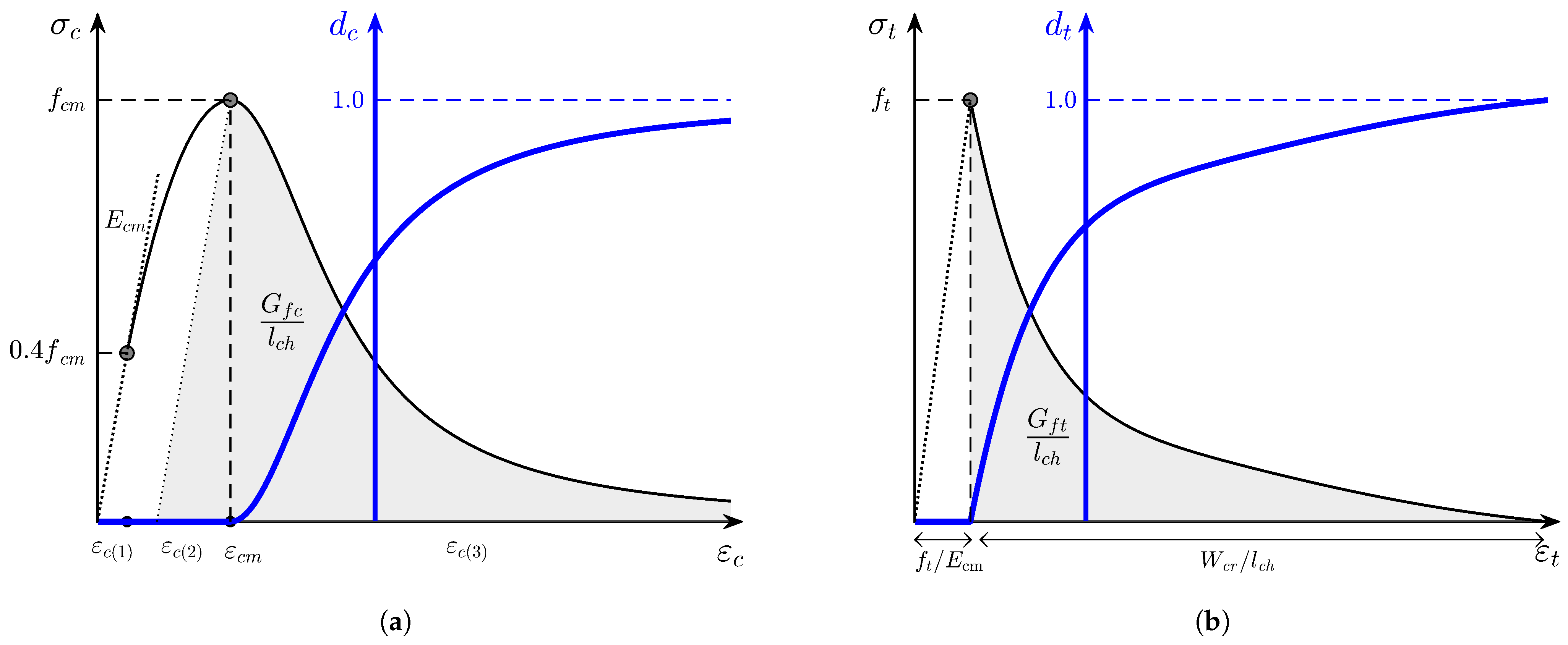
3.1.2. Reinforcing Steel
3.1.3. Bond between Concrete and Steel
3.2. Meshing
3.3. Boundary Conditions and Simulation Parameters
4. Parametric Study
5. Results and Discussion
5.1. FE Model Calibration
5.1.1. Global Behavior
5.1.2. Local Behavior
5.1.3. Cracking Pattern
5.1.4. Strains in Steel Rebars
5.2. Parametric Study
5.2.1. Global Behavior
5.2.2. Local Behaviors
5.2.3. Crack Assessment
6. Conclusions
- By combining the concrete damage plasticity with the energy-based uniaxial behavior models, employing the incompatible mesh element type, and considering the column axial load effect on the bond behavior, the global and local behaviors of the exterior and interior eccentric beam–column joints could be predicted precisely, as well as their cracking patterns.
- In addition to the anticipated flexure, shear, and normal force actions, the eccentric joint is subjected to a torsional moment, which generates additional shear stress on the joint zone, leading to accelerated joint damage. Moreover, the joints experience an out-of-plane deformation, which can potentially compromise the confinement of the beams within the joint, particularly in the case of interior joints.
- Between the tested parameters, the joint aspect ratio has the dominant impact on the behaviors of the joints by decreasing the joint shear capacity and consequently decreasing the beam–column subassembly capability to develop the beam plastic hinge. Additionally, an increase in the interior joint aspect ratio leads to a higher out-of-plane moment and a loss of joint confinement.
- An increase in the column aspect ratio resulted in slight enhancements in the joint shear capacity. However, it improves the beam–column subassembly’s capability to develop the beam plastic hinge.
- On average, the shear capacities of the exterior joints are three-fifths of the interior joints. However, ACI-318 and ACI-352 assume four-fifths for this percentage. Furthermore, as the joint aspect ratio exceeds 1.0, they overestimate the exterior joint shear strength.
Author Contributions
Funding
Institutional Review Board Statement
Informed Consent Statement
Data Availability Statement
Acknowledgments
Conflicts of Interest
Sample Availability
Abbreviations
| BJ | Beam joint |
| CDP | Concrete damage plasticity |
| DR | Drift ratio |
| FE | Finite element |
| FEM | Finite element model |
| J | Joint |
| RC | Reinforced concrete |
| STRA | Strain option |
Symbols
| Gross area of the column | |
| Column width | |
| Material dilatational wave speed | |
| Clear distance between rebar ribs | |
| D | Bar diameter |
| Nominal size of the concrete aggregate | |
| Beam depth | |
| Concrete damage in compression, column width | |
| Maximum aggregate size | |
| Concrete damage in tension | |
| E | Material modulus of elasticity |
| Concrete secant modulus of elasticity | |
| Concert initial modulus of elasticity | |
| Steel modulus of elasticity | |
| e | Beam Eccentricity |
| Steel bars elongation | |
| Bond force per a translator element | |
| Mean concrete compressive strength | |
| Main tensile strength | |
| Tensile strength | |
| Reinforcement steel’s ultimate strength | |
| Yield stress of steel | |
| Compressive crushing energy | |
| Tensile fracture energy | |
| Tensile-to-compressive meridian ratio | |
| Smallest element characteristic length | |
| l | Translator elements’ spacing |
| Mesh size | |
| Transverse compression force | |
| Yield load | |
| p | Steel behavior parameter for hardened part |
| s | Relative slip |
| , , | Relative slip limits |
| Joint shear force | |
| Crack opening displacement | |
| Crack opening displacement at the complete release of stress | |
| Strength level of the interaction stress contribution | |
| Stability time | |
| Drift ratio at | |
| Drift ratio at load | |
| Plastic potential eccentricity | |
| Compressive strain | |
| Strain at the compressive strength | |
| Compressive damaged plastic strain | |
| Compressive inelastic strain | |
| Steel fracture strain | |
| Tensile strain | |
| Strain at the tensile strength | |
| Yield hardening onset strain | |
| Steel strain at | |
| Yield plateau onset strain | |
| Shear stress coefficient | |
| Ductility ratio | |
| Poisson’s ratio | |
| Effective reinforcement ratio | |
| Material density | |
| Tensile stress normal to the crack direction | |
| Biaxial-to-uniaxial compressive strength ratio | |
| Local bond stress | |
| Frictional bond stress | |
| Bond Strength | |
| Dilatation angle | |
| Bond resistance increase factor for transverse compression force |
References
- Raffaelle, G.S.; Wight, J.K. R/C Eccentric Beam-Column Connections Subjected to Earthquake-Type Loading. Ph.D. Thesis, University of Michigan, Ann Arbor, MI, USA, 1992. [Google Scholar]
- Paulay, T.; Park, R.; Preistley, M. Reinforced concrete beam-column joints under seismic actions. J. Proc. 1978, 75, 585–593. [Google Scholar]
- Lafave, J.M.; Shin, M. Performance and design of eccentric reinforced concrete beam-column connections subjected to seismic lateral load reversals. In Proceedings of the Structures Congress Conferance, Austin, TX, USA, 30 April–2 May 2009; pp. 1525–1533. [Google Scholar] [CrossRef]
- Kim, J.; LaFave, J.M. Joint Shear Behavior of Reinforced Concrete Beam-Column Connections Subjected to Seismic Lateral Loading. Ph.D. Thesis, Newmark Structural Engineering Laboratory, University of Illinois at Urbana-Champaign, Urbana-Champaign, IL, USA, 2009. [Google Scholar]
- Somerville, G.; Taylor, H. The influence of reinforcement detailing on the strength of concrete structures. Struct. Eng. 1972, 50, 7–19. [Google Scholar]
- Kim, J.; LaFave, J.M. A simplified approach to joint shear behavior prediction of RC beam-column connections. Earthq. Spectra 2012, 28, 1071–1096. [Google Scholar] [CrossRef]
- Chun, S.C.; Shin, Y.S. Cyclic testing of exterior beam-column joints with varying joint aspect ratio. ACI Struct. J. 2014, 111, 693–704. [Google Scholar] [CrossRef]
- Joh, O.; Goto, Y.; Shibata, T. Behavior of reinforced concrete beam-column joints with eccentricity. ACI Spec. Publ. 1991, 123, 317–358. [Google Scholar]
- Lawrance, G.; Beattie, G.J.; Jacks, D.H. The Cyclic Load Performance of an Eccentric Beam-Column Joint; Technical Report 91-25126; Central Laboratories: Lower Hutt, New Zealand, 1991. [Google Scholar]
- Shin, M.S.; LaFave, J.M. Seismic performance of reinforced concrete eccentric beam-column connections with floor slabs. ACI Struct. J. 2004, 101, 403–412. [Google Scholar]
- Kusuhara, F.; Azukawa, K.; Shiohara, H.; Otani, S. Tests of reinforced concrete interior beam-column joint subassemblage with eccentric beams. In Proceedings of the 13th World Conference on Earthquake Engineering, Vancouver, BC, Canada, 1–6 August 2004; Volume 185. [Google Scholar]
- LaFave, J.M.; Bonacci, J.F.; Burak, B.; Shin, M. Eccentric beam-column connections. Concr. Int. 2005, 27, 58–62. [Google Scholar]
- RaffaelleE, G.S.; Wight, J.K. Reinforced concrete eccentric beam-column connections subjected to earthquake-type loading. Struct. J. 1995, 92, 45–55. [Google Scholar]
- Matsumoto, T.; Nishihara, H.; Nakao, M.; Castro, J. Experimental study on shear strength of eccentric beam-column joints subjected to seismic loading in super high rise reinforced concrete buildings. In Proceedings of the 15th World Conference on Earthquake Engineering, Lisbon, Portugal, 24–28 September 2012; pp. 6047–6056. [Google Scholar]
- Teng, S.; Zhou, H. Eccentric reinforced concrete beam-column joints subjected to cyclic loading. ACI Struct. J. 2003, 100, 139–148. [Google Scholar]
- Lee, H.J.; Ko, J.W. Eccentric reinforced concrete beam-column connections subjected to cyclic loading in principal directions. ACI Struct. J. 2007, 105, 380–392. [Google Scholar]
- Burak, B.; Wight, J.K. Experimental investigation on the seismic behavior of eccentric RC beam-column-slab connections. ACI Struct. J. 2008, 105, 154–162. [Google Scholar]
- Mogili, S.; Kuang, J.S.; Huang, R.Y. Effects of beam-column geometry and eccentricity on seismic behaviour of RC beam-column knee joints. Bull. Earthq. Eng. 2019, 17, 2671–2686. [Google Scholar] [CrossRef]
- Chen, C.C.; Chen, G.K. Cyclic behavior of reinforced concrete eccentric beam-column corner joints connecting spread-ended beams. ACI Struct. J. 1999, 96, 443–449. [Google Scholar]
- Ma, C.; Wang, Z.; Smith, S.T. Seismic performance of large-scale RC eccentric corner beam-column-slab joints strengthened with CFRP systems. J. Compos. Constr. 2020, 24, 04019066. [Google Scholar] [CrossRef]
- Wong, H.F.; Liu, Y.; Luk, S.H.; Lee, P.M.; Kwong, W.H. Effects of eccentricity on seismic behavior of non-seismically designed reinforced concrete beam-column joint. In Proceedings of the 2019 World Congress on Advances in Structural Engineering and Mechanics Conference, Jeju Island, Republic of Korea, 17–21 September 2019; Volume 427. [Google Scholar]
- Goto, Y.; Joh, O. Shear resistance of RC interior eccentric beam to column joints. In Proceedings of the 13th World Conference on Earthquake Engineering, Vancouver, BC, Canada, 1–6 August 2004; Volume 649, pp. 1–6. [Google Scholar]
- Lee, H.J.; Yu, S.Y. Cyclic response of exterior beam-column joints with different anchorage methods. ACI Struct. J. 2009, 106, 329–339. [Google Scholar]
- Li, B.; Pan, T.C.; Tran, C.T.N. Effects of axial compression load and eccentricity on seismic behavior of non-seismically detailed interior beam-wide column joints. J. Struct. Eng.-ASCE 2009, 135, 774–784. [Google Scholar] [CrossRef]
- Li, B.; Kai, Q.; Xue, W.C. Effects of eccentricity on the seismic rehabilitation performance of non-seismically detailed interior beamwide column joints. J. Compos. Constr. 2012, 16, 507–519. [Google Scholar] [CrossRef]
- ACI. ASCE Committee 352 Recommendations for Design of Beam-Column Connections in Monolithic Reinforced Concrete Structures (ACI 352R-02) (Reapproved 2010) [s]; American Concrete Institute: Farmington Hills, MI, USA, 2002; Volume M1. [Google Scholar]
- ACI. Building Code Requirements for Structural Concrete and Commentary (ACI 318-19); American Concrete Institute: Farmington Hills, MI, USA, 2019. [Google Scholar]
- Rashid, Y. Ultimate strength analysis of prestressed concrete pressure vessels. Nucl. Eng. Des. 1968, 7, 334–344. [Google Scholar] [CrossRef]
- Lubliner, J.; Oliver, J.; Oller, S.; Oñate, E. A plastic-damage model for concrete. Int. J. Solids Struct. 1989, 25, 299–326. [Google Scholar] [CrossRef]
- Lee, J.; Fenves, G.L. Plastic-damage model for cyclic loading of concrete structures. J. Eng. Mech. 1998, 124, 892–900. [Google Scholar] [CrossRef]
- Smith, M. ABAQUS User’s Manual, Version 2018; Dassault Systemes Simulia Corp: Providence, RI, USA, 2018. [Google Scholar]
- Li, Z.X.; Liu, H.; Shi, Y.; Ding, Y. Numerical and analytical investigation on progressive collapse resistance of prestressed precast concrete frame structures. J. Build. Eng. 2022, 52, 104417. [Google Scholar] [CrossRef]
- Pham, A.T.; Tan, K.H.; Yu, J. Numerical investigations on static and dynamic responses of reinforced concrete sub-assemblages under progressive collapse. Eng. Struct. 2017, 149, 2–20. [Google Scholar] [CrossRef]
- Nogales, A.; de la Fuente, A. Numerical-aided flexural-based design of fibre reinforced concrete column-supported flat slabs. Eng. Struct. 2021, 232, 111745. [Google Scholar] [CrossRef]
- Behnam, H.; Kuang, J.; Samali, B. Parametric finite element analysis of RC wide beam-column connections. Comput. Struct. 2018, 205, 28–44. [Google Scholar] [CrossRef]
- Dehghani, A.; Mozafari, A.R.; Aslani, F. Evaluation of the efficacy of using engineered cementitious composites in RC beam-column joints. Structures 2020, 27, 151–162. [Google Scholar] [CrossRef]
- Mirzabagheri, S.; Tasnimi, A.A.; Issa, F. Experimental and numerical study of reinforced concrete interior wide beam-column joints subjected to lateral load. Can. J. Civ. Eng. 2018, 45, 947–957. [Google Scholar] [CrossRef]
- Najafgholipour, M.; Dehghan, S.; Dooshabi, A.; Niroomandi, A. Finite element analysis of reinforced concrete beam-column connections with governing joint shear failure mode. Lat. Am. J. Solids Struct. 2017, 14, 1200–1225. [Google Scholar] [CrossRef]
- Genikomsou, A.S.; Polak, M.A. Finite element analysis of punching shear of concrete slabs using damaged plasticity model in ABAQUS. Eng. Struct. 2015, 98, 38–48. [Google Scholar] [CrossRef]
- Ibrahim, H.A.; Fahmy, M.F.; Wu, Z. Numerical study of steel-to-FRP reinforcement ratio as a design-tool controlling the lateral response of SFRC beam-column joints. Eng. Struct. 2018, 172, 253–274. [Google Scholar] [CrossRef]
- Peng, Z.; Dai, S.B.; Pi, Y.L.; Zhang, Y.C.; Huang, J. Seismic performance of end-plate connections between T-shaped CFST columns and RC beams. J. Constr. Steel Res. 2018, 145, 167–183. [Google Scholar] [CrossRef]
- Xu, L.; Wei, C.; Li, B. Damage evolution of steel-polypropylene hybrid fiber reinforced concrete: Experimental and numerical investigation. Adv. Mater. Sci. Eng. 2018, 2018, 1719427. [Google Scholar] [CrossRef]
- Earij, A.; Alfano, G.; Cashell, K.; Zhou, X. Nonlinear three-dimensional finite-element modelling of reinforced-concrete beams: Computational challenges and experimental validation. Eng. Fail. Anal. 2017, 82, 92–115. [Google Scholar] [CrossRef]
- Faleschini, F.; Bragolusi, P.; Zanini, M.A.; Zampieri, P.; Pellegrino, C. Experimental and numerical investigation on the cyclic behavior of RC beam column joints with EAF slag concrete. Eng. Struct. 2017, 152, 335–347. [Google Scholar] [CrossRef]
- Xiao, K.; Zhang, Q.; Jia, B. Cyclic behavior of prefabricated reinforced concrete frame with infill slit shear walls. Front. Struct. Civ. Eng. 2016, 10, 63–71. [Google Scholar] [CrossRef]
- Yimer, M.A.; Aure, T.W. Numerical investigation of reinforced concrete and steel fiber-reinforced concrete exterior beam-column joints under cyclic loading. Iran. J. Sci. Technol. Trans. Civ. Eng. 2022, 46, 2249–2273. [Google Scholar] [CrossRef]
- Ridwan. Reinforced Concrete Beam-Column Joints Strengthened in Shear with Embedded Bars. Ph.D. Thesis, College of Engineering & Physical Sciences, The University of Birmingham, Birmingham, UK, 2016. [Google Scholar]
- Wang, Y.H.; Tang, Q.; Nie, X. Comparative investigation on influences of concrete material constitutive models on structural behavior. Constr. Build. Mater. 2017, 144, 475–483. [Google Scholar] [CrossRef]
- Demirtaş, Y.; Yurdakul, Ö.; Avşar, Ö. Lattice modelling of substandard RC beam-column joints considering localization issues. Structures 2023, 47, 2515–2530. [Google Scholar] [CrossRef]
- Rosso, M.M.; Asso, R.; Aloisio, A.; Di Benedetto, M.; Cucuzza, R.; Greco, R. Corrosion effects on the capacity and ductility of concrete half-joint bridges. Constr. Build. Mater. 2022, 360, 129555. [Google Scholar] [CrossRef]
- A706/A706M; ASTM. Standard Specification for Deformed and Plain Low-Alloy Steel Bars for Concrete Reinforcement. Technical Report; ASTM International: West Conshohocken, PA, USA, 2016.
- AIJ. AIJ Standard for Structural Calculation of Reinforced Concrete Structures; Architectural Institute of Japan: Tokyo, Japan, 1999. [Google Scholar]
- JIS G 3112; JIS Steel Bars for Concrete Reinforcement. Japanese Industrial Standards: Tokyo, Japan, 2020.
- JIS G 3137; JIS Steel Bars for Concrete Reinforcement. Japanese Industrial Standards: Tokyo, Japan, 2020.
- Taerwe, L.; Matthys, S. Fib Model Code for Concrete Structures 2010; Ernst & Sohn, Wiley: Berlin, Germany, 2013. [Google Scholar]
- Rashid, M.; Mansur, M.; Paramasivam, P. Correlations between mechanical properties of high-strength concrete. J. Mater. Civ. Eng. 2002, 14, 230–238. [Google Scholar] [CrossRef]
- Chen, W.F. Plasticity in Reinforced Concrete; J. Ross Publishing: New York, NY, USA, 2007. [Google Scholar]
- Vonk, R.A. Softening of Concrete Loaded in Compression. Ph.D. Thesis, Eindhoven University of Technology Eindhoven, Eindhoven, The Netherlands, 1992. [Google Scholar]
- German, M.; Pamin, J. FEM simulations of cracking in RC beams due to corrosion progress. Arch. Civ. Mech. Eng. 2015, 15, 1160–1172. [Google Scholar] [CrossRef]
- Wörle, P. Enhanced shear punching capacity by the use of post installed concrete screws. Eng. Struct. 2014, 60, 41–51. [Google Scholar] [CrossRef]
- Bažant, Z.P. Instability, ductility, and size effect in strain-softening concrete. ASCE J. Eng. Mech. Div. 1976, 102, 331–344. [Google Scholar] [CrossRef]
- Krätzig, W.; Pölling, R. An elasto-plastic damage model for reinforced concrete with minimum number of material parameters. Comput. Struct. 2004, 82, 1201–1215. [Google Scholar] [CrossRef]
- Alfarah, B.; López-Almansa, F.; Oller, S. New methodology for calculating damage variables evolution in Plastic Damage Model for RC structures. Eng. Struct. 2017, 132, 70–86. [Google Scholar] [CrossRef]
- Juárez-Luna, G.; Tena-Colunga, A.; Ayala, G. Computational modelling of rc slabs cracking with an embedded discontinuity formulation. Lat. Am. J. Solids Struct. 2015, 12, 2539–2561. [Google Scholar]
- Cornelissen, H. Experiments and theory for the application of fracture mechanics to normal and lightweight concrete. Fract. Toughness Fract. Energy Concr. 1986, 565–575. Available online: https://cir.nii.ac.jp/crid/1570572699262849536 (accessed on 20 June 2023).
- Hordijk, D.A. Local Approach to Fatigue of Concrete. Ph.D. Thesis, Department of Civil Engineering and Geosciences Delft University Delft, Delft, The Netherlands, 1993. [Google Scholar]
- Wosatko, A.; Genikomsou, A.; Pamin, J.; Polak, M.A.; Winnicki, A. Examination of two regularized damage-plasticity models for concrete with regard to crack closing. Eng. Fract. Mech. 2018, 194, 190–211. [Google Scholar] [CrossRef]
- Seok, S.; Haikal, G.; Ramirez, J.A.; Lowes, L.N. High-resolution finite element modeling for bond in high-strength concrete beam. Eng. Struct. 2018, 173, 918–932. [Google Scholar] [CrossRef]
- Lagier, F.; Massicotte, B.; Charron, J.P. 3D nonlinear finite-element modeling of lap splices in UHPFRC. J. Struct. Eng.-ASCE 2016, 142, 04016087. [Google Scholar] [CrossRef]
- Yu, T.; Teng, J.; Wong, Y.; Dong, S. Finite element modeling of confined concrete-II: Plastic-damage model. Eng. Struct. 2010, 32, 680–691. [Google Scholar] [CrossRef]
- Lim, J.C.; Ozbakkaloglu, T.; Gholampour, A.; Bennett, T.; Sadeghi, R. Finite-element modeling of actively confined normal-strength and high-strength concrete under uniaxial, biaxial, and triaxial compression. J. Struct. Eng.-ASCE 2016, 142, 04016113. [Google Scholar] [CrossRef]
- Mander, J.B. Seismic Design of Bridge Piers. Ph.D. Thesis, University of Canterbury, Civil Engineering, Christchurch, New Zealand, 1983. [Google Scholar]
- Somma, G.; Vit, M.; Frappa, G.; Pauletta, M.; Pitacco, I.; Russo, G. A new cracking model for concrete ties reinforced with bars having different diameters and bond laws. Eng. Struct. 2021, 235, 112026. [Google Scholar] [CrossRef]
- Huang, Z.; Engström, B.; Magnusson, J. Experimental and analytical studies of the bond behaviour of deformed bars in high strength concrete. In Proceedings of the 4th International Symposium on the Utilization of High Strength/High Performance Concrete, Paris, France, 29–31 May 1996. [Google Scholar]
- Li, H.G.; Cen, S.; Cen, Z.Z. Hexahedral volume coordinate method (HVCM) and improvements on 3D Wilson hexahedral element. Comput. Methods Appl. Mech. Eng. 2008, 197, 4531–4548. [Google Scholar] [CrossRef]
- Koutromanos, I. Fundamentals of Finite Element Analysis: Linear Finite Element Analysis; John Wiley & Sons: Hoboken, NJ, USA, 2018. [Google Scholar]
- Zhou, P.; Cen, S.; Huang, J.; Li, C.; Zhang, Q. An unsymmetric 8-node hexahedral element with high distortion tolerance. Int. J. Numer. Methods Eng. 2017, 109, 1130–1158. [Google Scholar] [CrossRef]
- Kožar, I.; Rukavina, T.; Ibrahimbegović, A. Method of incompatible modes–overview and application. Građevinar 2018, 70, 19–29. [Google Scholar]
- Stern, F.; Wilson, R.V.; Coleman, H.W.; Paterson, E.G. Comprehensive approach to verification and validation of CFD simulations—Part 1: Methodology and procedures. J. Fluids Eng. 2001, 123, 793–802. [Google Scholar] [CrossRef]
- Sun, E.Q. Shear locking and hourglassing in MSC Nastran, ABAQUS, and ANSYS. In Proceedings of the MSC Software Users Meeting, São Paulo, Brazil, July 2006. [Google Scholar]
- He, P.; Sun, Q.; Liang, K. Generalized modal element method: Part I Theory and its application to eight-node asymmetric and symmetric solid elements in linear analysis. Comput. Mech. 2019, 63, 755–781. [Google Scholar] [CrossRef]
- He, P.; Sun, Q.; Liang, K. Generalized modal element method: Part II Application to eight-node asymmetric and symmetric solid-shell elements in linear analysis. Comput. Mech. 2019, 63, 783–804. [Google Scholar] [CrossRef]
- Hillerborg, A.; Modéer, M.; Petersson, P.E. Analysis of crack formation and crack growth in concrete by means of fracture mechanics and finite elements. Cem. Concr. Res. 1976, 6, 773–781. [Google Scholar] [CrossRef]
- Bažant, Z.P.; Oh, B.H. Crack band theory for fracture of concrete. Matériaux Constr. 1983, 16, 155–177. [Google Scholar] [CrossRef]
- Bažant, Z.P.; Pijaudier-Cabot, G. Measurement of characteristic length of nonlocal continuum. J. Eng. Mech. 1989, 115, 755–767. [Google Scholar] [CrossRef]
- Volokh, K. Characteristic length of damage localization in concrete. Mech. Res. Commun. 2013, 51, 29–31. [Google Scholar] [CrossRef]
- Carstensen, J.V.; Jomaas, G.; Pankaj, P. Element size and other restrictions in finite-element modeling of reinforced concrete at elevated temperatures. J. Eng. Mech. 2013, 139, 1325–1333. [Google Scholar] [CrossRef]
- Thai, H.T.; Vo, T.P.; Nguyen, T.K.; Pham, C.H. Explicit simulation of bolted endplate composite beam-to-CFST column connections. Thin-Walled Struct. 2017, 119, 749–759. [Google Scholar] [CrossRef]
- Thai, H.T.; Uy, B. Finite element modelling of blind bolted composite joints. J. Constr. Steel Res. 2015, 112, 339–353. [Google Scholar] [CrossRef]
- Paulay, T. Equilibrium criteria for reinforced concrete beam-column joints. ACI Struct. J. 1989, 86, 635–643. [Google Scholar]
- Li, B.; Lam, E.S.S.; Wu, B.; Wang, Y.y. Effect of high axial load on seismic behavior of reinforced concrete beam-column joints with and without strengthening. ACI Struct. J. 2015, 112, 713–723. [Google Scholar] [CrossRef]
- Hwang, S.J.; Lee, H.J.; Liao, T.F.; Wang, K.C.; Tsai, H.H. Role of hoops on shear strength of reinforced concrete beam-column joints. Struct. J. 2005, 102, 445–453. [Google Scholar]
- Chen, G.; Teng, J.; Chen, J.; Xiao, Q. Finite element modeling of debonding failures in FRP-strengthened RC beams: A dynamic approach. Comput. Struct. 2015, 158, 167–183. [Google Scholar] [CrossRef]
- Shin, M.; LaFave, J. Reinforced concrete edge beam-column-slab connections subjected to earthquake loading. Mag. Concr. Res. 2004, 56, 273–292. [Google Scholar] [CrossRef]
- Park, R. Evaluation of ductility of structures and structural assemblages from laboratory testing. Bull. N. Z. Soc. Earthq. Eng. 1989, 22, 155–166. [Google Scholar] [CrossRef]
- Kim, J.; LaFave, J.M. Probabilistic joint shear strength models for design of RC beam-column connections. ACI Struct. J. 2008, 105, 770–780. [Google Scholar]
- Kim, J.; LaFave, J.A. Key influence parameters for the joint shear behaviour of reinforced concrete (RC) beam-column connections. Eng. Struct. 2007, 29, 2523–2539. [Google Scholar] [CrossRef]
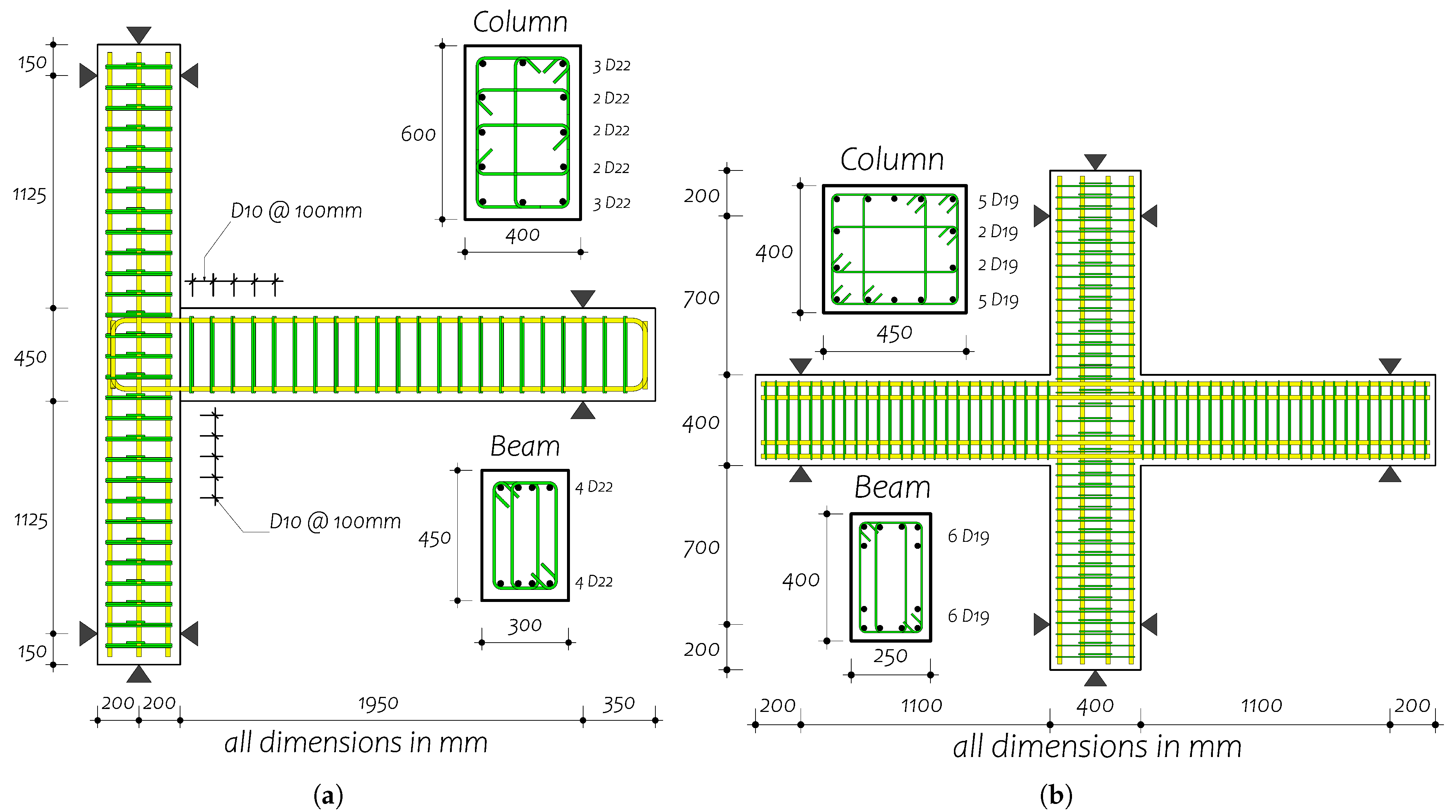
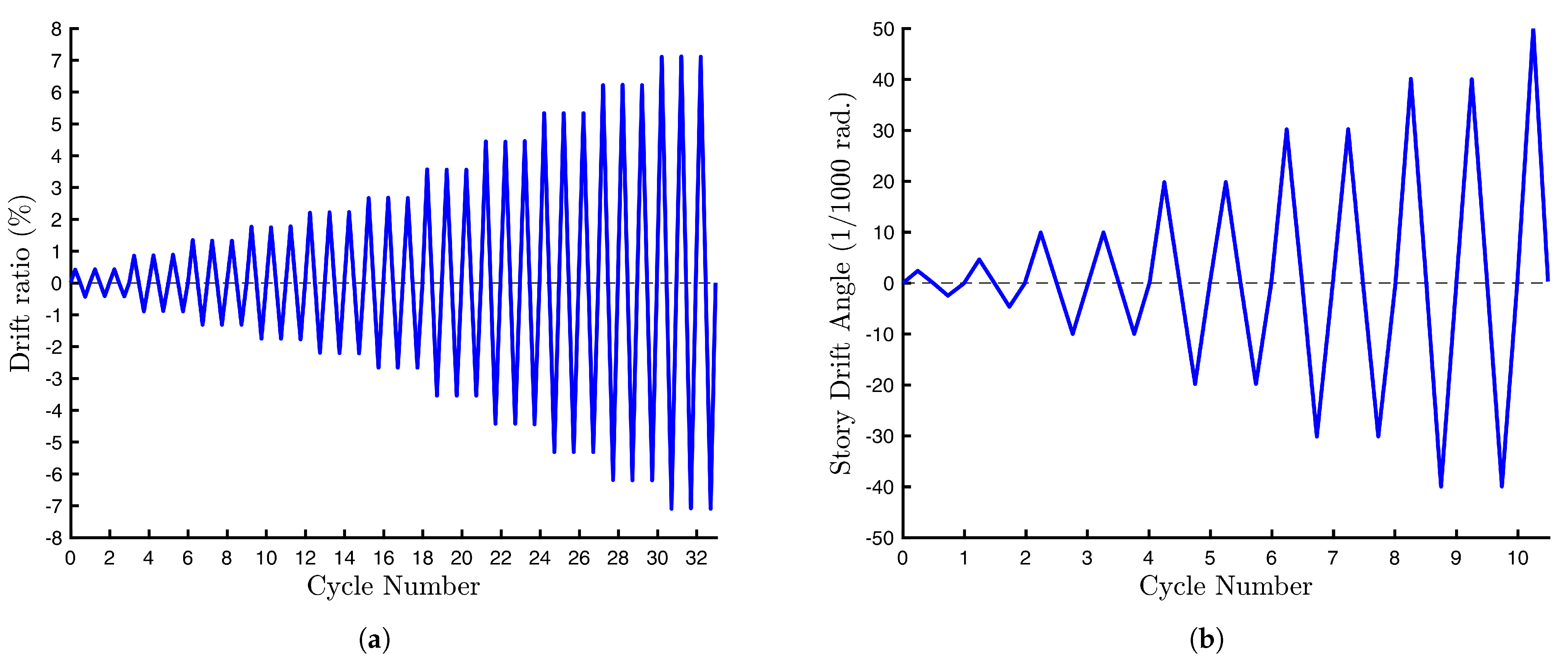
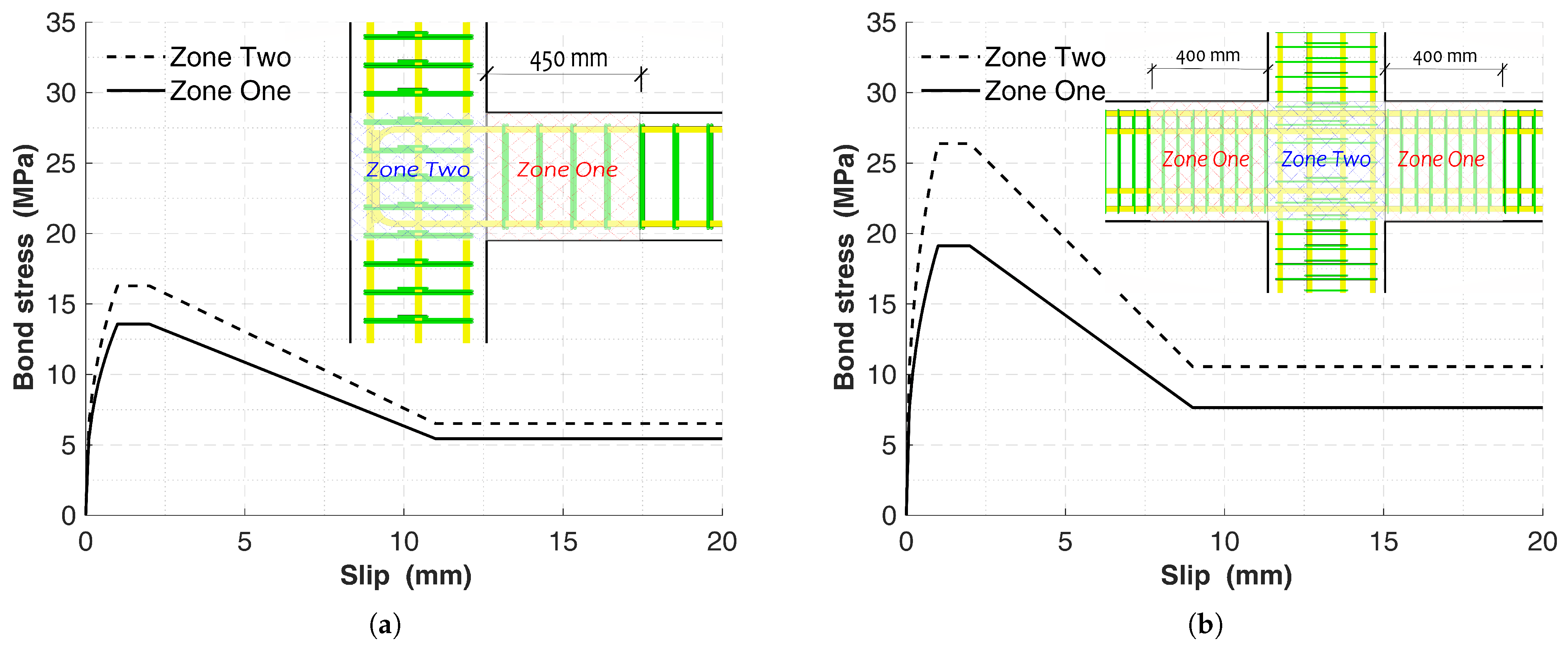

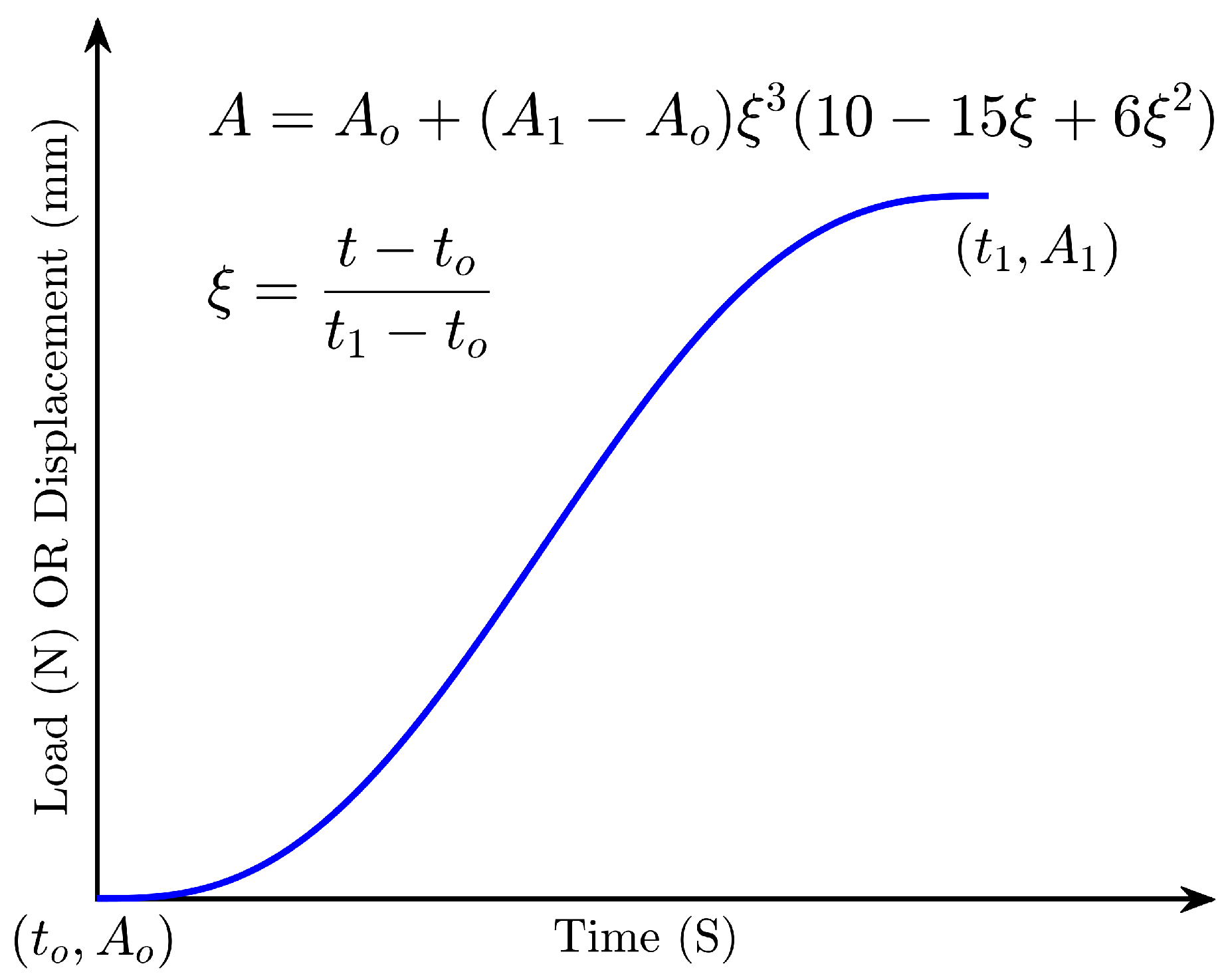



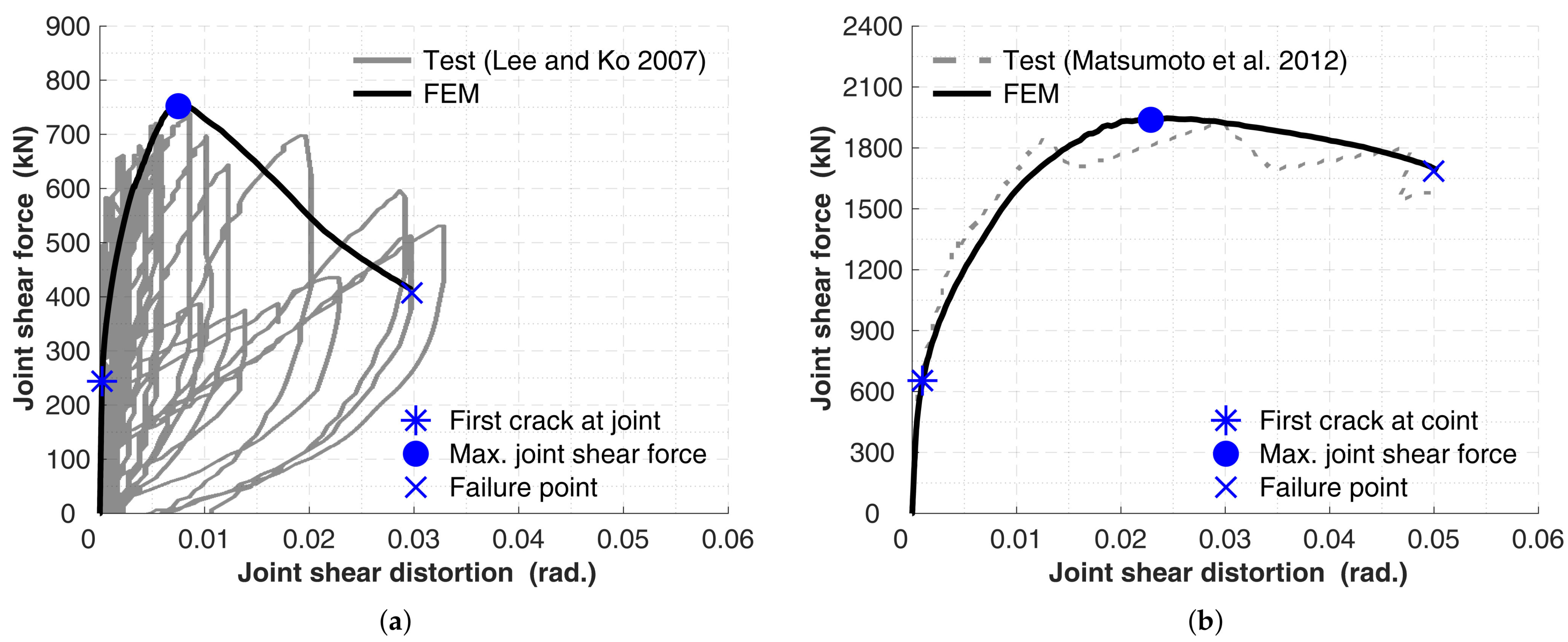
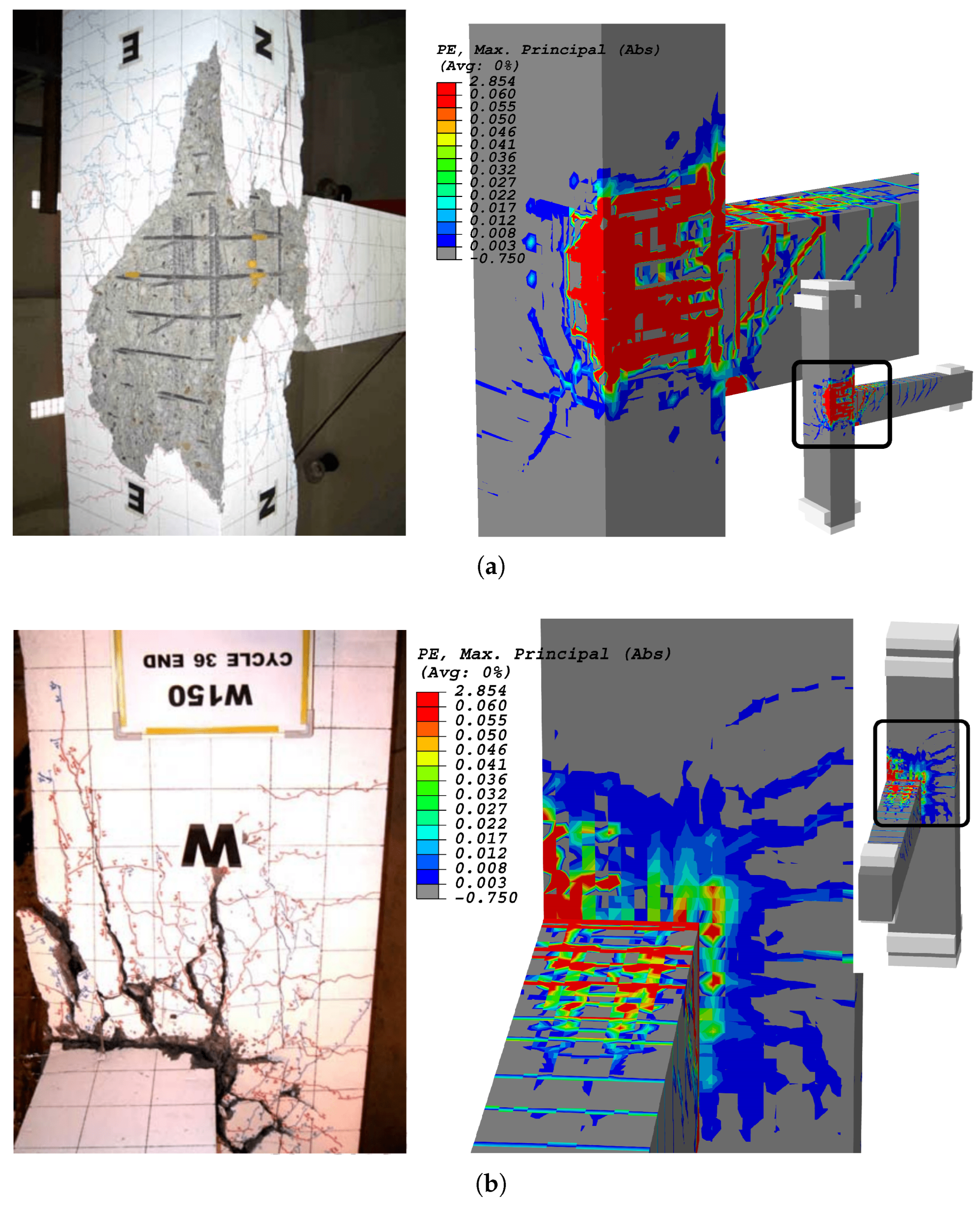

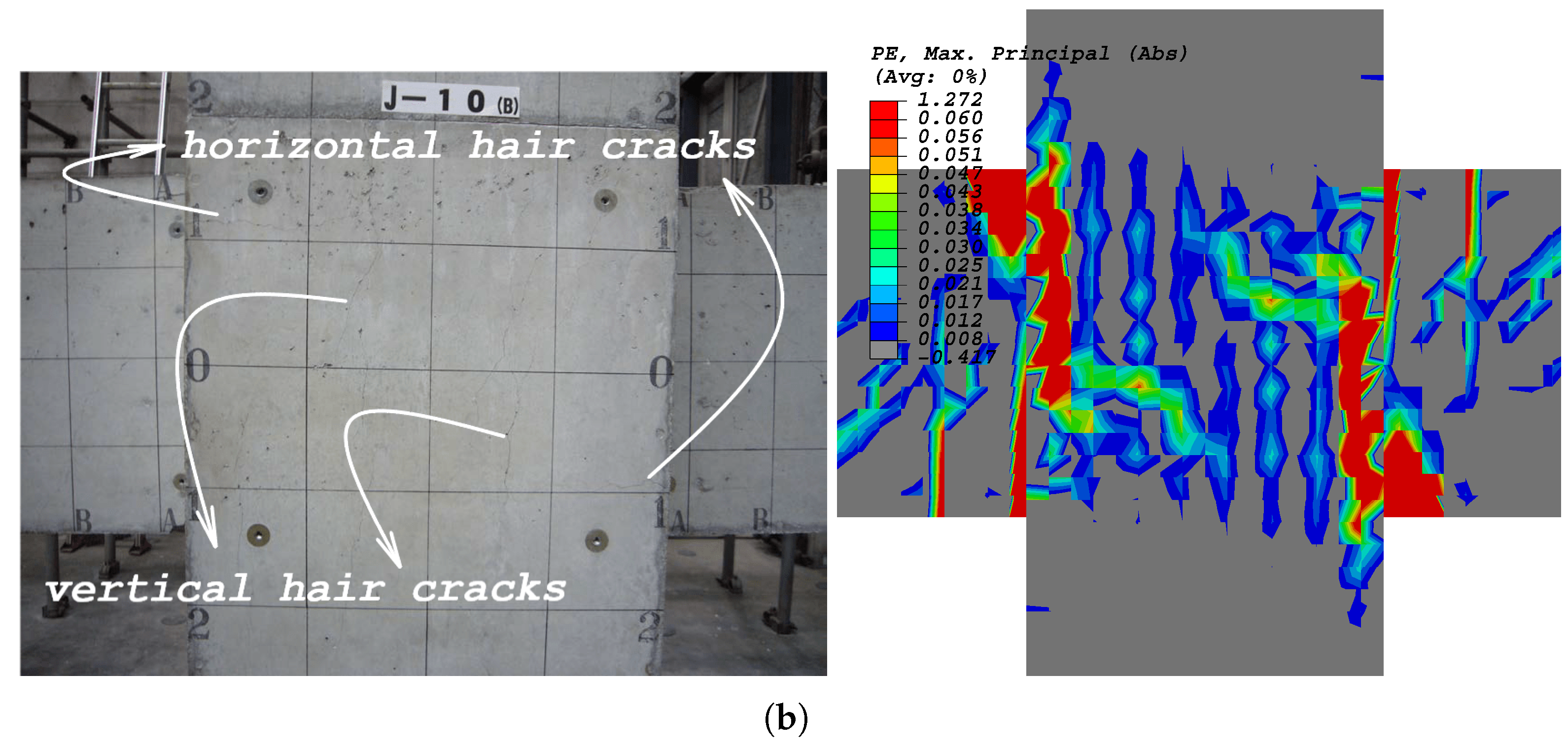
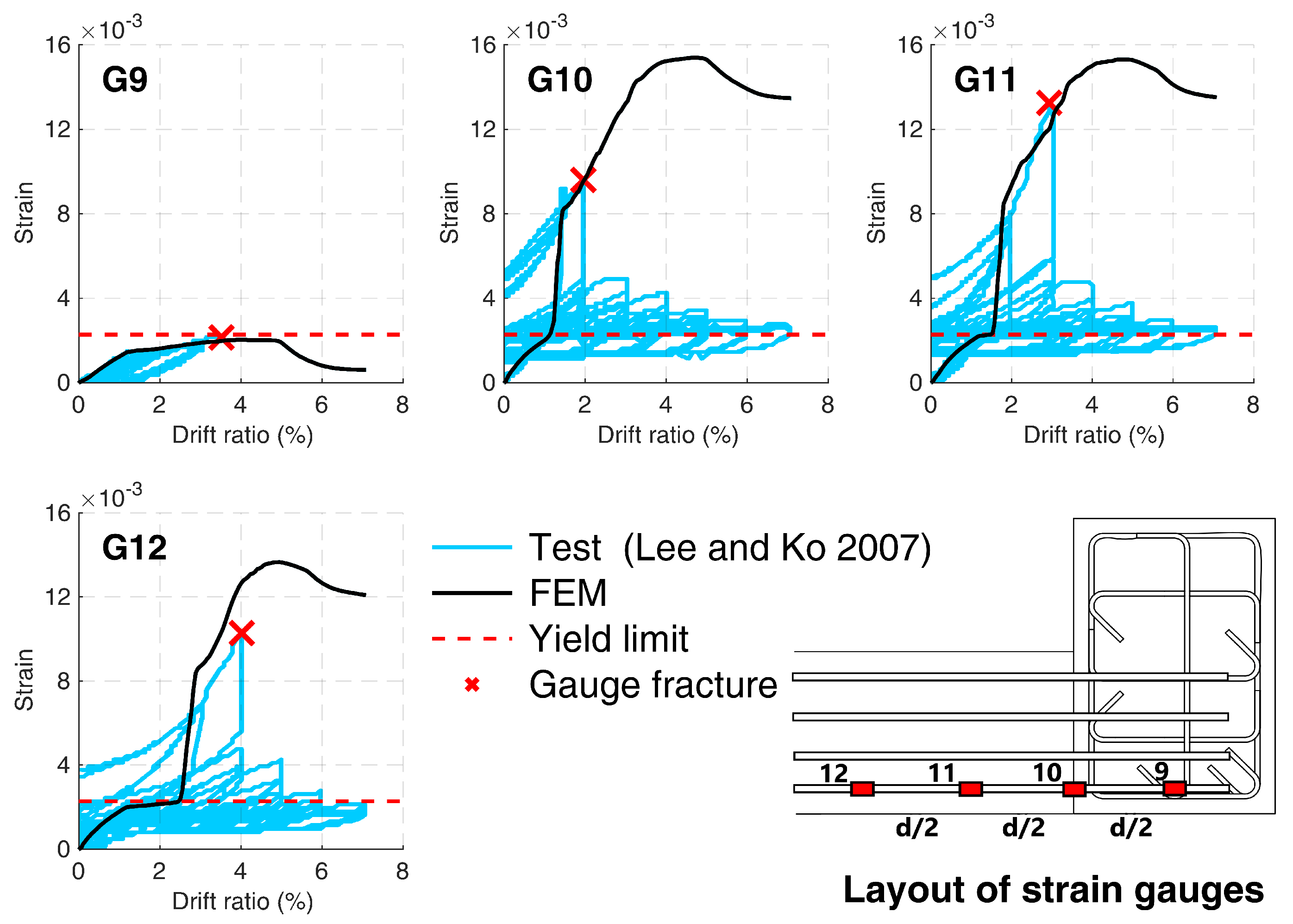

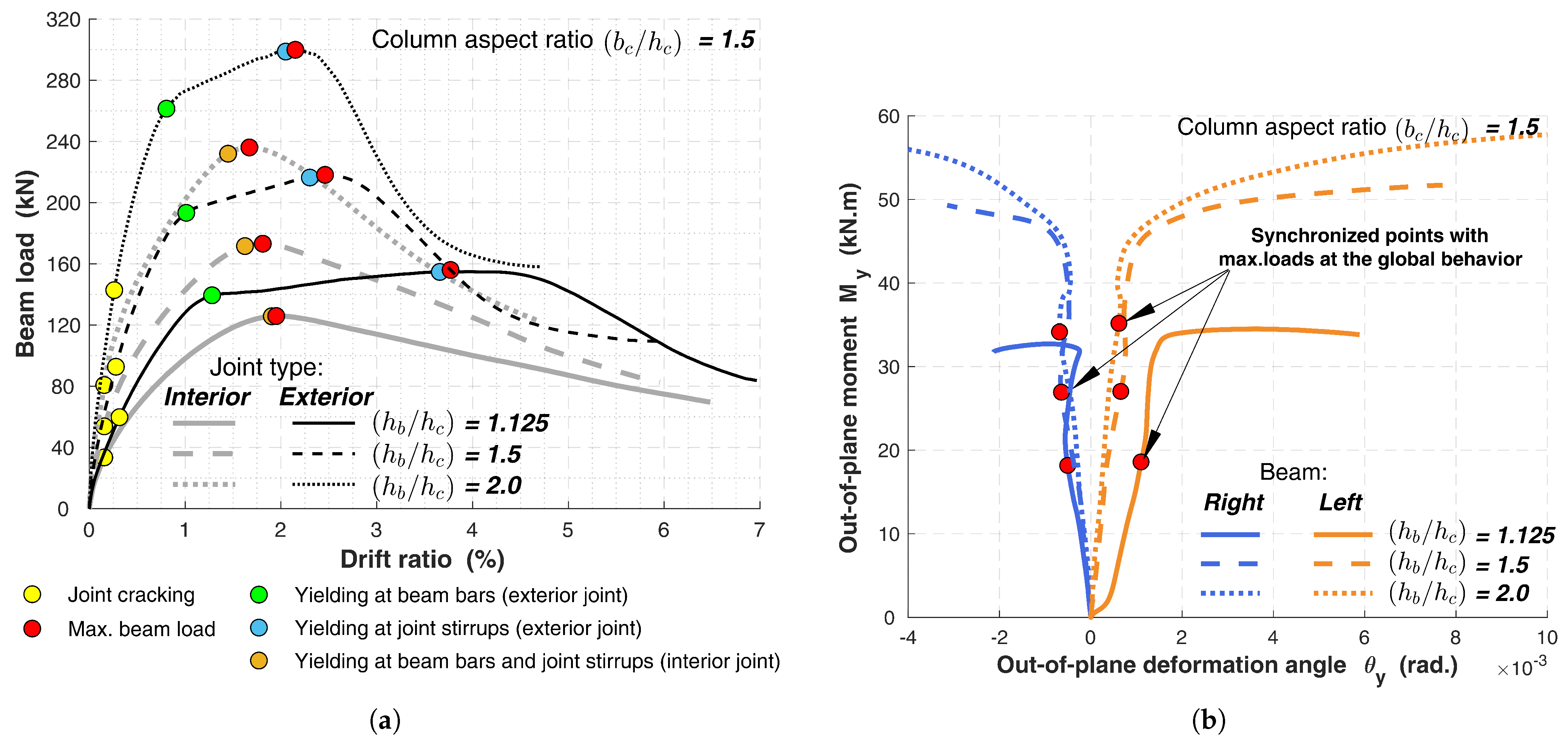

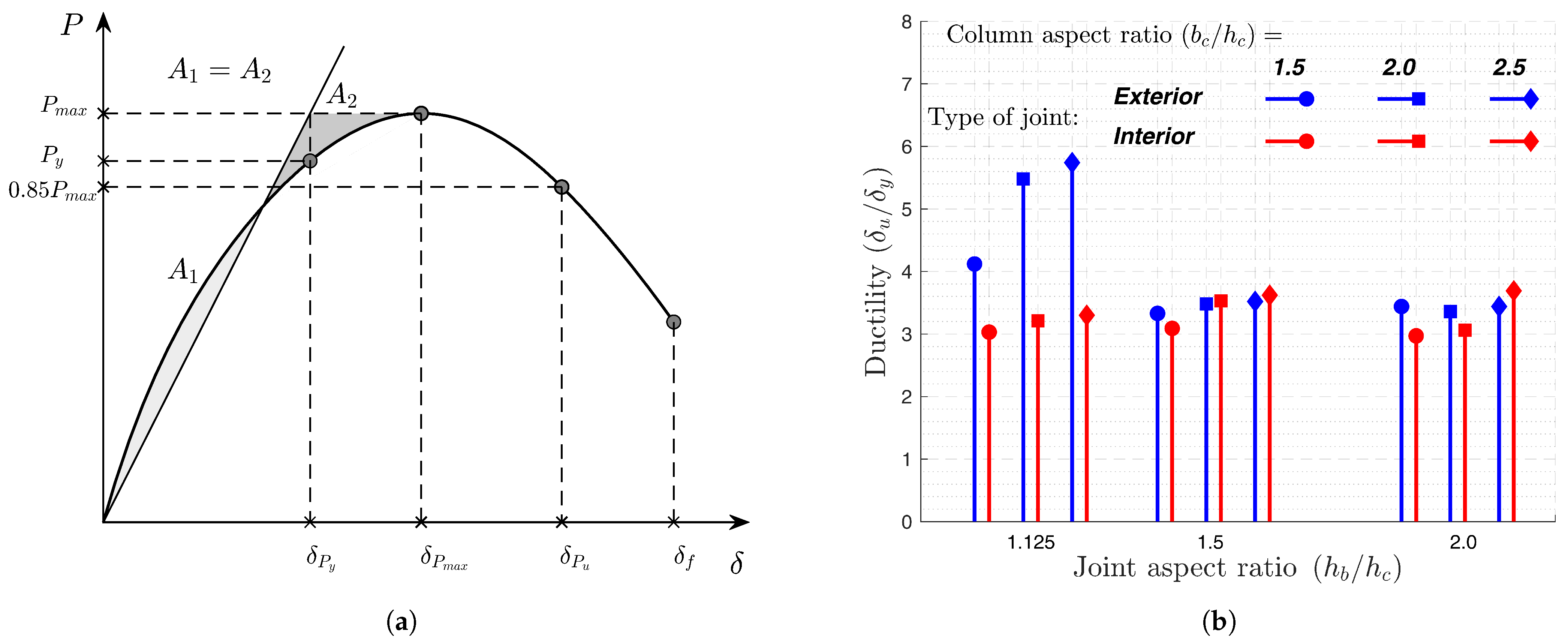
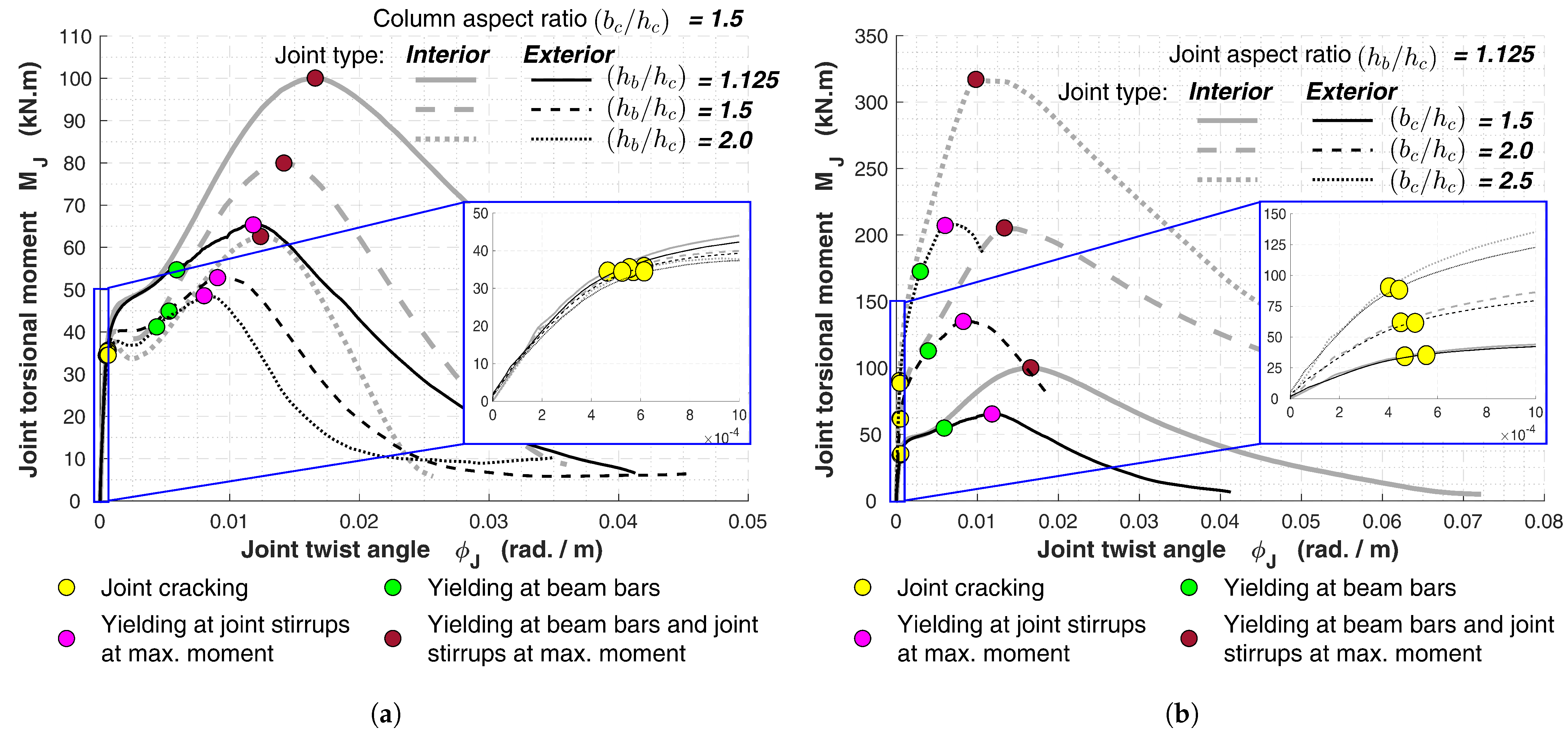


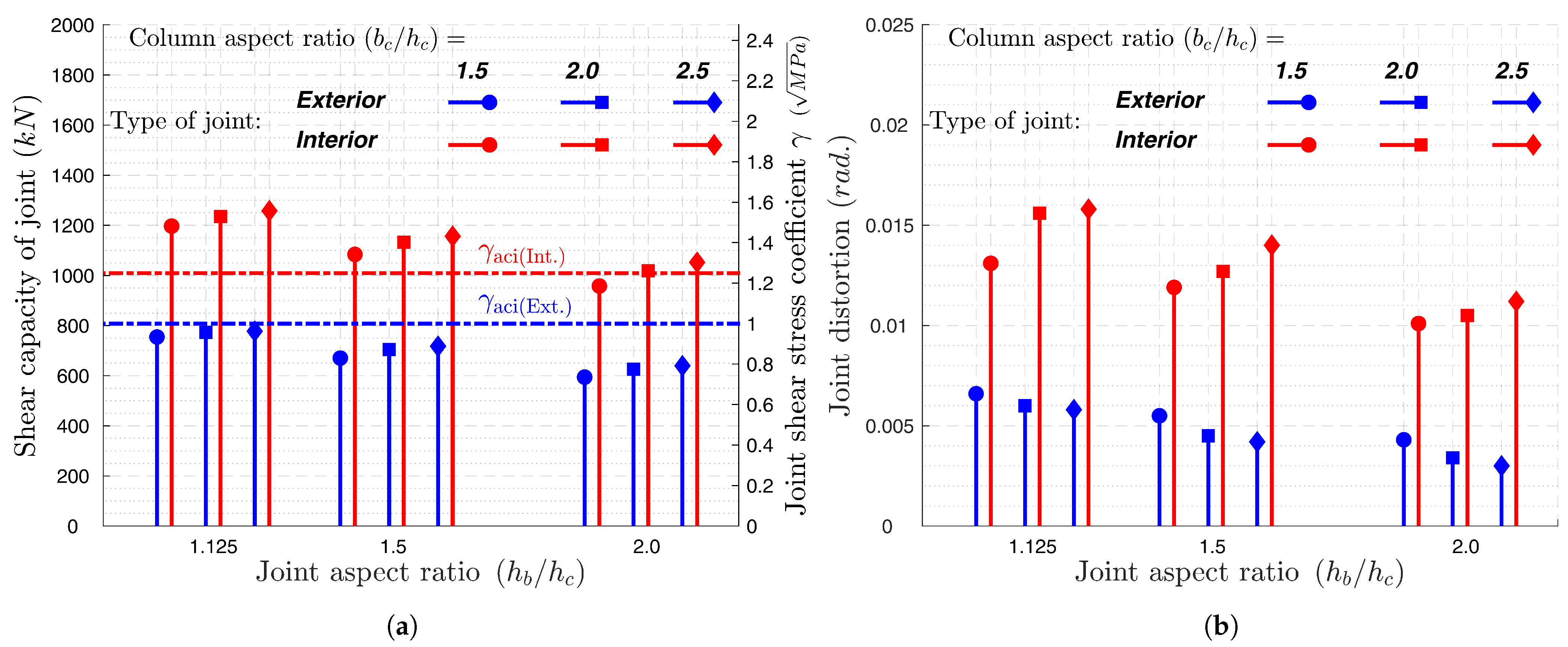

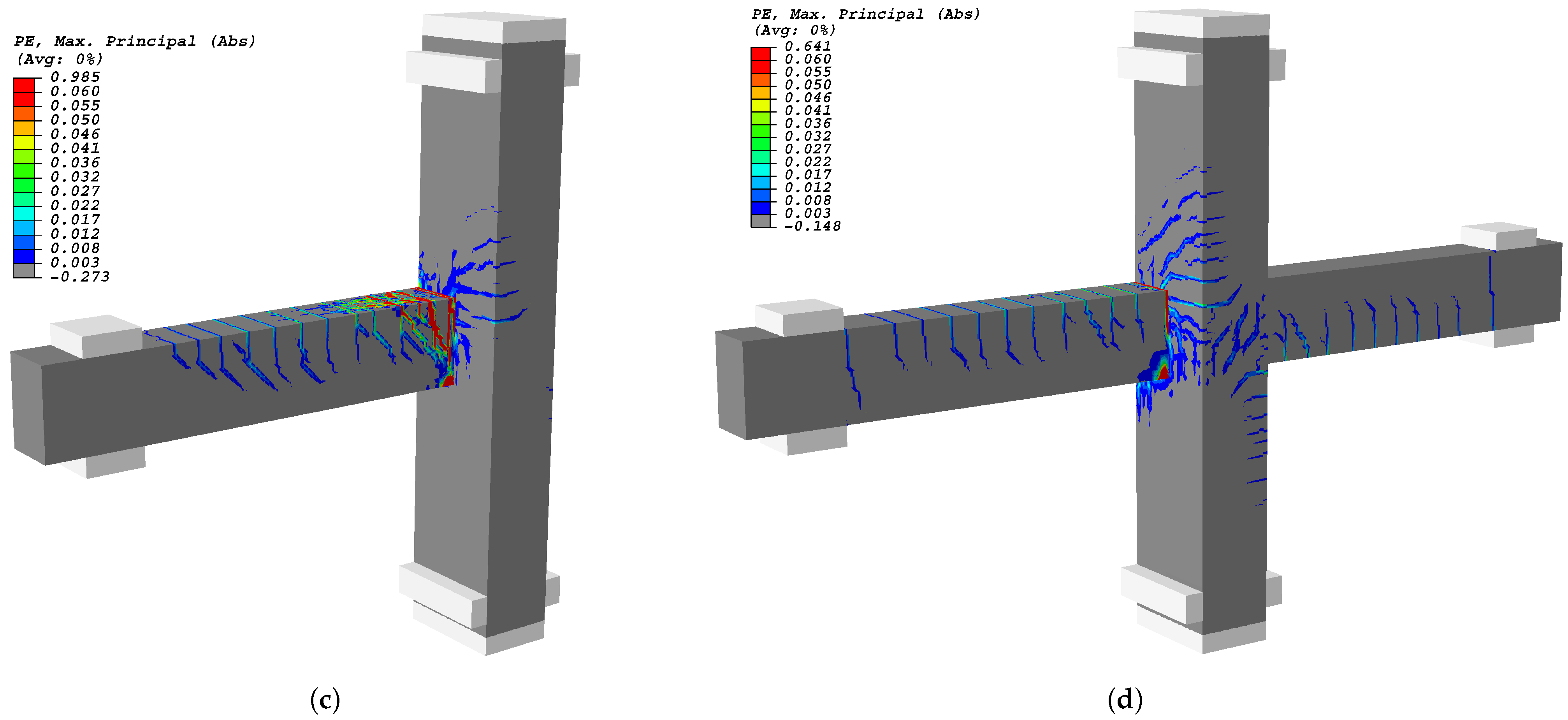
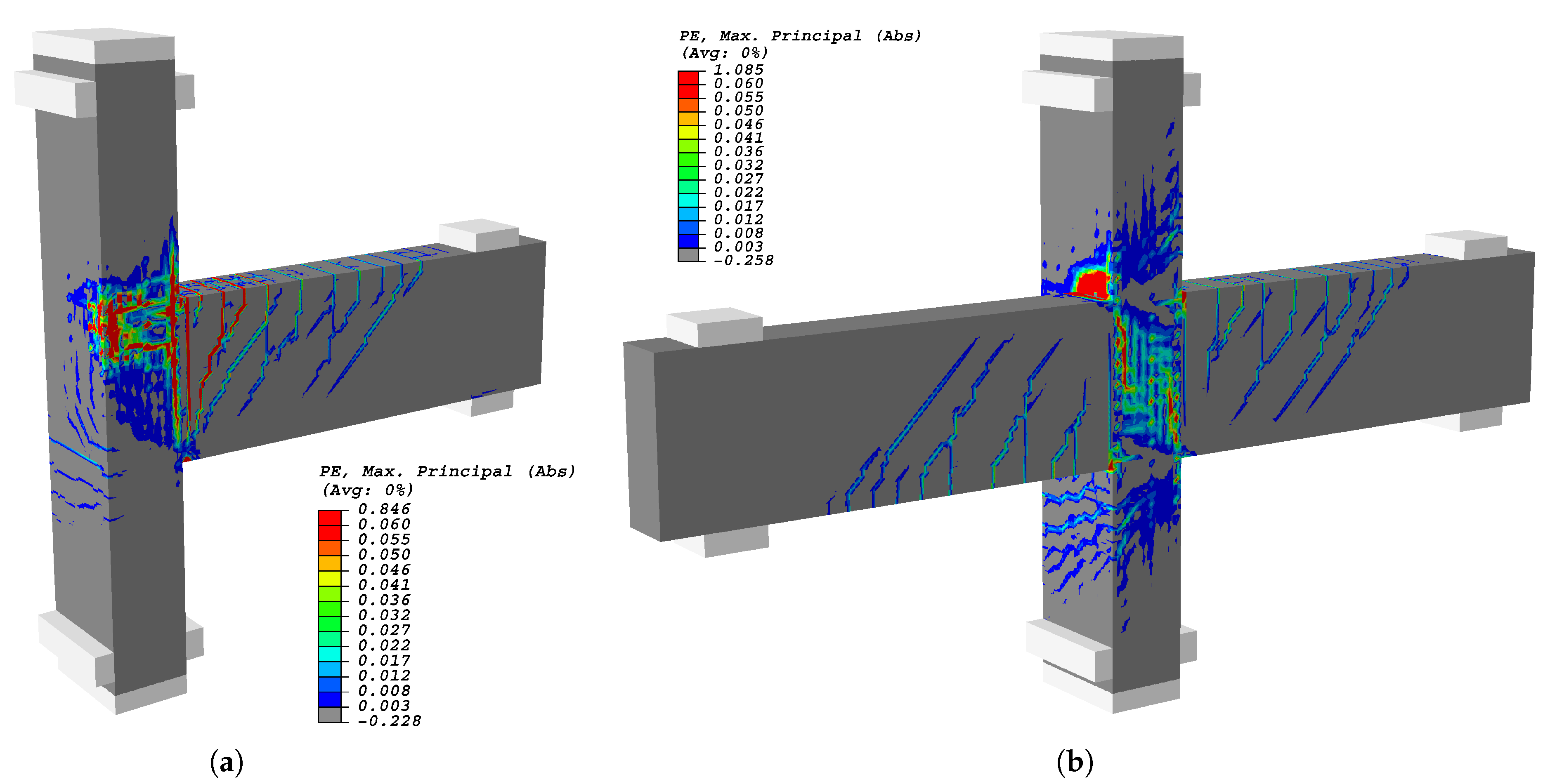
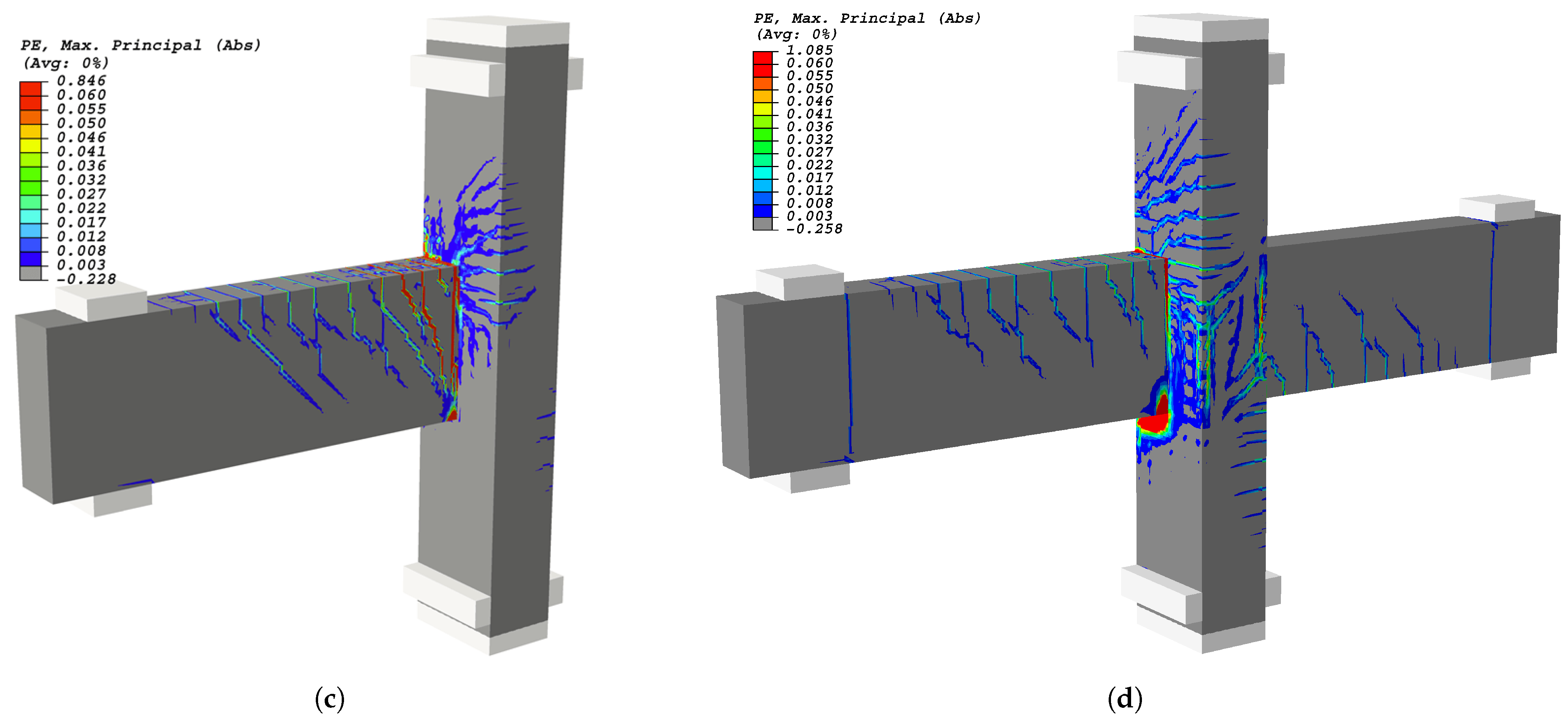
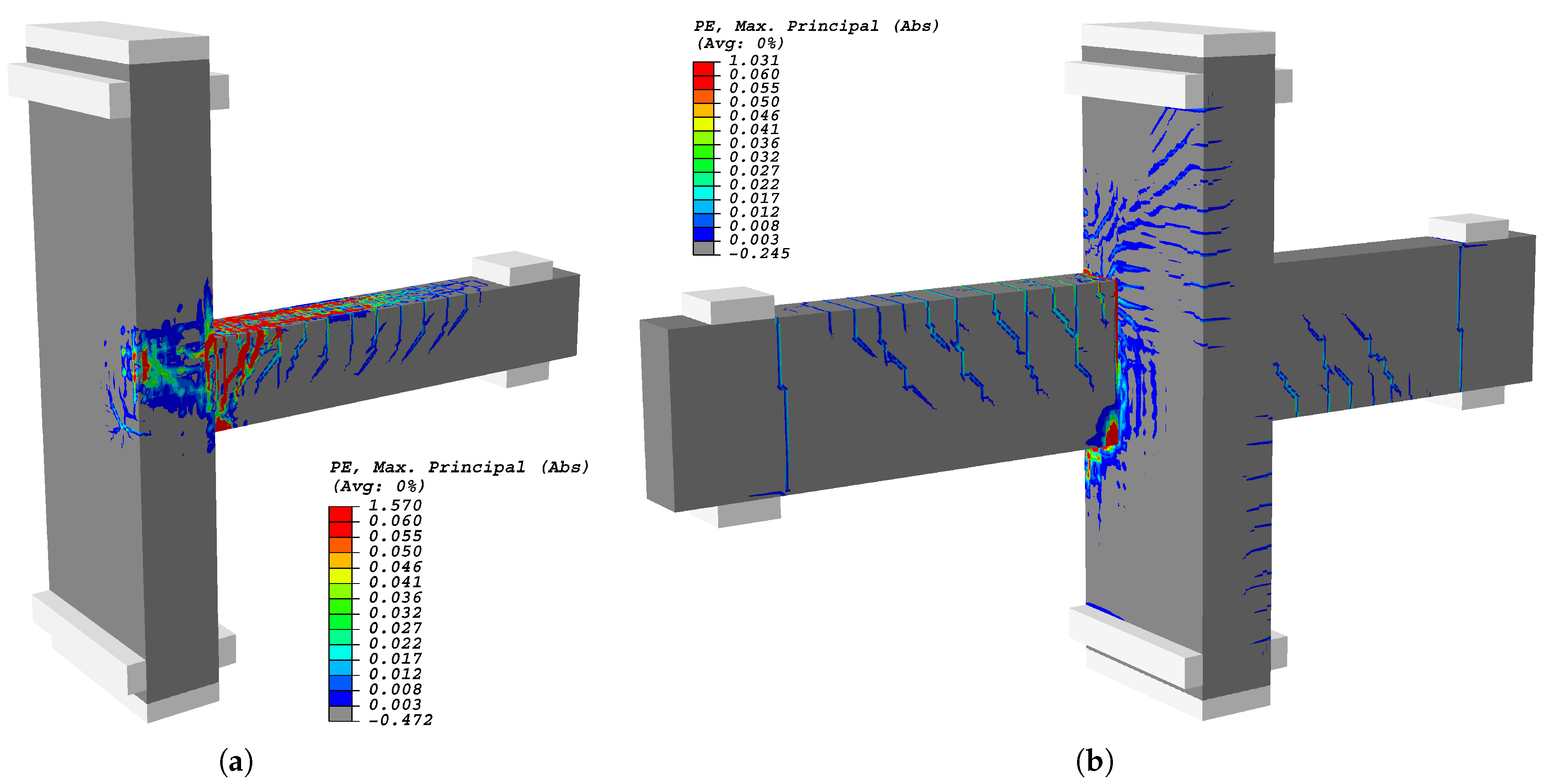
| Ref. | (MPa) | (GPa) | (MPa) | (N/mm) | (N/mm) | |||||||
|---|---|---|---|---|---|---|---|---|---|---|---|---|
| Exterior connection | 29.5 | 23.15 | 0.0016 | 0.2 | 1.7 | 0.06 | 4.5 | 2/3 | 0.1 | 1.16 | Beam | 48 |
| Column | 56 | |||||||||||
| Interior connection | 57.0 | 30.6 | 0.0017 | 2.7 | 0.1 | 12 | Beam | 35 | ||||
| Column | 56 | |||||||||||
| Ref. | Steel Type | Bar Size | (MPa) | (MPa) | (MPa) | el % | |
|---|---|---|---|---|---|---|---|
| Exterior connection | ASTM A706 [51] | No. 7 22 mm long bars for beams and columns | 200,000 | 454.5 | 0.00227 | 682.4 | 10 |
| No. 3 10 mm stirrups for beams and columns | 200,000 | 471.3 | 0.00236 | 715.3 | 12 | ||
| Interior connection | USD685 [53] | No. 6 19 mm long bars for columns | 202,000 | 746 | 0.0055 | 1011 | 12 |
| No. 6 19 mm long bars for beams | 185,000 | 710 | 0.0056 | 928 | 12 | ||
| SBPD1275/1420 [54] | 6.2 mm stirrups for beams and columns | 199,000 | 1276 | 0.0077 | 1453 | 5 |
| Beam Dimensions (mm) | Joint Type | Column Dimensions (mm) | Eccentricity () | Joint Aspect Ratios () | Column Aspect Ratios () |
|---|---|---|---|---|---|
| 450 × 300 | Interior | 600 × 400 | 0.25 | 1.125 | 1.5 |
| 800 × 400 | 0.3125 | 2.0 | |||
| 1000 × 400 | 0.35 | 2.5 | |||
| Exterior | 600 × 400 | 0.25 | 1.5 | ||
| 800 × 400 | 0.3125 | 2.0 | |||
| 1000 × 400 | 0.35 | 2.5 | |||
| 600 × 300 | Interior | 600 × 400 | 0.25 | 1.5 | 1.5 |
| 800 × 400 | 0.3125 | 2.0 | |||
| 1000 × 400 | 0.35 | 2.5 | |||
| Exterior | 600 × 400 | 0.25 | 1.5 | ||
| 800 × 400 | 0.3125 | 2.0 | |||
| 1000 × 400 | 0.35 | 2.5 | |||
| 800 × 300 | Interior | 600 × 400 | 0.25 | 2.0 | 1.5 |
| 800 × 400 | 0.3125 | 2.0 | |||
| 1000 × 400 | 0.35 | 2.5 | |||
| Exterior | 600 × 400 | 0.25 | 1.5 | ||
| 800 × 400 | 0.312 | 2.0 | |||
| 1000 × 400 | 0.35 | 2.5 |
Disclaimer/Publisher’s Note: The statements, opinions and data contained in all publications are solely those of the individual author(s) and contributor(s) and not of MDPI and/or the editor(s). MDPI and/or the editor(s) disclaim responsibility for any injury to people or property resulting from any ideas, methods, instructions or products referred to in the content. |
© 2023 by the authors. Licensee MDPI, Basel, Switzerland. This article is an open access article distributed under the terms and conditions of the Creative Commons Attribution (CC BY) license (https://creativecommons.org/licenses/by/4.0/).
Share and Cite
Abdel-Latif, M.A.; Nassr, A.A.; Sumelka, W.; Mohamed, M.M.; Abd El-Shafi, A.G.; Soliman, E. Effect of Geometric Parameters on the Behavior of Eccentric RC Beam–Column Joints. Buildings 2023, 13, 1980. https://doi.org/10.3390/buildings13081980
Abdel-Latif MA, Nassr AA, Sumelka W, Mohamed MM, Abd El-Shafi AG, Soliman E. Effect of Geometric Parameters on the Behavior of Eccentric RC Beam–Column Joints. Buildings. 2023; 13(8):1980. https://doi.org/10.3390/buildings13081980
Chicago/Turabian StyleAbdel-Latif, Mostafa A., Amr A. Nassr, Wojciech Sumelka, Mohamed M. Mohamed, Aly G. Abd El-Shafi, and Eslam Soliman. 2023. "Effect of Geometric Parameters on the Behavior of Eccentric RC Beam–Column Joints" Buildings 13, no. 8: 1980. https://doi.org/10.3390/buildings13081980
APA StyleAbdel-Latif, M. A., Nassr, A. A., Sumelka, W., Mohamed, M. M., Abd El-Shafi, A. G., & Soliman, E. (2023). Effect of Geometric Parameters on the Behavior of Eccentric RC Beam–Column Joints. Buildings, 13(8), 1980. https://doi.org/10.3390/buildings13081980







